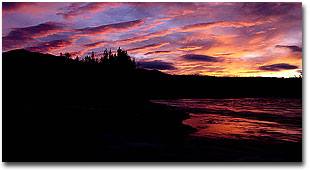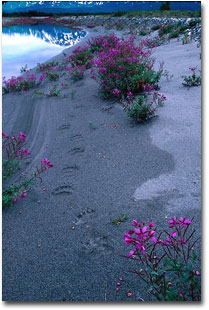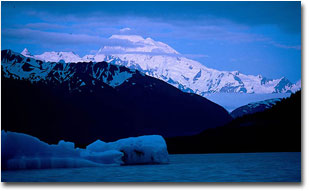|
|
 Photo Itinerary... Tatsheshini Exposure
Text and photography Copyright Pete and Alice Bengeyfield
This is without a doubt the most scenic trip Iíve ever been on, and that includes the Grand Canyon. The last four days are a continuous ďeyegasmĒ. Itís infinitely wild. You donít hike out of here. The Tat flows down a corridor of snow draped mountains for 132 miles from Dalton Post on the Haines Highway in the Yukon, to Dry Bay on the Gulf of Alaska. After it joins with the Alsek , about 2/3 of the way through the trip, it becomes the second largest river entering the Pacific. Summer flows, when the glaciers are melting, commonly reach 100,000 cubic feet per second (the Colorado maxes out at 30,000 now). There are no roads, trails, buildings, airstrips, or patrols. The Tatshenshini is about as wild as it gets. Photographically however, it can be very frustrating. Because of the summer weather patterns, much of the time the serrated horizons are only tantilizingly visible between gaps in the low clouds, and the light is southeast-Alaska-flat. Now, thatís OK for a lot of subjects, but with the scenery potential that exists here, youíd make a pact with the devil for those long, low, summer sunrises and sunsets. It never did really rain on us, but it was cloudy and foggy a good deal of the time. Be prepared to do the best with what you get.
We did have sun for a layover day at Walker Glacier though. Here you can hike up on the glacier (bring crampons or ice axes), pass sheer walls of honeycombed blue ice and peer into aquamarine slot canyons. These channels, cut into the glacial ice by meltwater, provide a kaleidoscope of cold colors, but photographing them is difficult. Thereís no way to get inside, and setting up a tripod on the edges is tricky. If you figured it out, youíd have Antelope Canyon in blues. The glacier hike eventually ends in a maze of crevasses and you have to turn around. All thatís left is to return to camp, sit around the evening fire, cool your twenty year-old scotch with ten-thousand year-old ice, and watch the alpenglow turn the peaks into mounds of raspberry sherbet. Doesnít get much better than that. Wildlife sightings were pretty spotty. We saw seven grizzlies. Three of them came by various camps, but were very wary. We surprised another on a gravel bar and it bolted to the river, hitting the water about fifty yards ahead of us. The river was about ĺ mile wide at this point, and we rowed hard to close the distance. We never came close. The bear kept ahead of us across the entire river, scaled an eight-foot embankment like it wasnít there and disappeared. Impressive. Bald eagles are common, but never close enough to photograph. I talked to a guy who once had a wolverine walk through camp. People who like to photograph mosquitoes will have no shortage of opportunities. I didnít take a long lens, and never missed it. Big glass would be a hassle on a raft, and the chances to use it arenít that many. As with any river trip, keeping your gear clean and dry is a big challenge. It is often windy, and the campsites are dusty. My Pelican Case worked great. I took lenses ranging from 20mm to 200mm and used them all a lot. The mid-range telephotos were handy because when youíre floating, the mountains are not that close and shorter lenses leave too much river-foreground to deal with. I wish Iíd had a 300 for the icebergs, as the extra compression would have made for better shots in some cases. There are lots of macro opportunities for wildflowers.
The Tatshenshini-Alsek is a premier river trip. The opportunity to photograph large, spectacular landscapes that are seldom viewed through a lens is enormous. The feeling of endless, untrammeled wilderness is unequalled. And hey, I was only kidding about the weatherÖ.. Pete and Alice - NPN 082 Comments on this article? Send them to the editor. |
|
|
 The float trip on the Tatshenshini-Alsek takes eleven days. If you had sunshine for that time Ė 22 sunrises/sets Ė youíd need an extra raft to carry the film. And therein lies the problem. We had two days with sunshine Ė one sunrise, one sunset. Ah, but the potentialÖ..
The float trip on the Tatshenshini-Alsek takes eleven days. If you had sunshine for that time Ė 22 sunrises/sets Ė youíd need an extra raft to carry the film. And therein lies the problem. We had two days with sunshine Ė one sunrise, one sunset. Ah, but the potentialÖ..  What you get is like nothing else. Hanging glaciers, icebergs, narrow canyons, wildflowers, grizzlies, eagles, steep cliffs, waterfalls and rapids Ė the Tat pretty much has it all. The climax of the trip is Alsek Lake, probably your last camp. Itís a large lake, about eighteen square miles, and much of it is covered with icebergs. You float among them on the way in (early in the year they can block passage), often pushing the smaller ones aside. The largest ones, towering gargoyles of blue ice, dwarf the rafts. The icebergs come from the Alsek Glacier, which makes up about half the lakeshore. Periodically, the booming cannon shots of ice calving off the glacierís face echo across the lake. This is a photographic paradise. The bergs are constantly shifting, giving you different combinations to arrange against the background of mountains and glaciers. Mt. Fairweather, 15,000 plus feet, hangs over the entire scene like a huge fang. Having the sun here would be fantastic. We didnít.
What you get is like nothing else. Hanging glaciers, icebergs, narrow canyons, wildflowers, grizzlies, eagles, steep cliffs, waterfalls and rapids Ė the Tat pretty much has it all. The climax of the trip is Alsek Lake, probably your last camp. Itís a large lake, about eighteen square miles, and much of it is covered with icebergs. You float among them on the way in (early in the year they can block passage), often pushing the smaller ones aside. The largest ones, towering gargoyles of blue ice, dwarf the rafts. The icebergs come from the Alsek Glacier, which makes up about half the lakeshore. Periodically, the booming cannon shots of ice calving off the glacierís face echo across the lake. This is a photographic paradise. The bergs are constantly shifting, giving you different combinations to arrange against the background of mountains and glaciers. Mt. Fairweather, 15,000 plus feet, hangs over the entire scene like a huge fang. Having the sun here would be fantastic. We didnít. If you decided to pack all your floating/camping gear from the Lower 48 to the put-in, the logistics would be pretty daunting. Fortunately you can rent all you need in Haines, and get your meals set up as well. We flew to Juneau, and took the Alaska ferry system to Haines. From there, the outfitter will take you to the put-in (about three hours) and help you rig the boats. After that, itís all downriver. Itís not a difficult float. The largest rapid is Class III, and all the rapids are encountered in the first couple of hours. After that, itís pretty easy. Finding the right channel is often tricky because of the large number of gravel bars in the river. Itís not uncommon to be standing in six inches of water in the middle of a half-mile wide river trying to get the raft unstuck. Hip boots are a must. The current moves you along at about 10-12 mph, and thereís really only about 30 hours of floating time on the entire trip. Campsites are not common, but are spaced conveniently. Most camps have hikes nearby, but other than that, itís pretty hard to get around on foot because of the thick brush. The hikes are all pretty steep and short, but they get you high enough for some great views of the valley. There is no ground access to the take-out at Dry Bay, so you have to make charter flight arrangements to get picked up and returned to Haines. Itís about an hour flight, entirely over rock and ice. The trip requires a permit from Glacier Bay National Park to take out, and there is only one issued per day. No permit is required to put in. The entire trip (minus getting to Haines) cost about $620.00 per person.
If you decided to pack all your floating/camping gear from the Lower 48 to the put-in, the logistics would be pretty daunting. Fortunately you can rent all you need in Haines, and get your meals set up as well. We flew to Juneau, and took the Alaska ferry system to Haines. From there, the outfitter will take you to the put-in (about three hours) and help you rig the boats. After that, itís all downriver. Itís not a difficult float. The largest rapid is Class III, and all the rapids are encountered in the first couple of hours. After that, itís pretty easy. Finding the right channel is often tricky because of the large number of gravel bars in the river. Itís not uncommon to be standing in six inches of water in the middle of a half-mile wide river trying to get the raft unstuck. Hip boots are a must. The current moves you along at about 10-12 mph, and thereís really only about 30 hours of floating time on the entire trip. Campsites are not common, but are spaced conveniently. Most camps have hikes nearby, but other than that, itís pretty hard to get around on foot because of the thick brush. The hikes are all pretty steep and short, but they get you high enough for some great views of the valley. There is no ground access to the take-out at Dry Bay, so you have to make charter flight arrangements to get picked up and returned to Haines. Itís about an hour flight, entirely over rock and ice. The trip requires a permit from Glacier Bay National Park to take out, and there is only one issued per day. No permit is required to put in. The entire trip (minus getting to Haines) cost about $620.00 per person.